CFP: Submissions for Arc Journal
CFP: The editors of Arc: The Journal of the Faculty of Religious Studies,
McGill University solicit submissions with a contemporary or a historical
focus on the themes of freedom, liberty, and liberation in religious
thought and practice for the 2013 issue (Vol. 41). Possible
topics for submissions might include:
· Religious or theological interpretations of freedom, liberty, and/or
liberation
· Freedom of religion
· Freedom or liberation from suffering
· Freedom and virtue, e.g. sin, wrongdoing, and the problem of evil
· Relations among concepts of freedom, liberty, law, destiny, and providence
· Concepts of liberation in religio-political contexts
· Concepts of freedom in the ancient world, and their reception (or lack
thereof). E.g. The Greek concept of Freedom in the Jewish, Greco-Roman, and
Ancient Christian worlds.
The editors also solicit reviews of recently published books related to the
study of religion.
Arc is an interdisciplinary, refereed journal published annually by the
Faculty of Religious Studies, McGill University. The journal combines the
talents of professors and graduate students in offering space for scholarly
discussions on various aspects of the academic
study of religion, including method and theory in the study of religion.
Arc encourages submissions from diverse religious traditions and
perspectives. The submission deadline is March 31st, 2013. For detailed
submission guidelines, please consult the Guidelines for Contributors (PDF)
on our website. All electronic correspondence,
including request for review copies of books, should be sent to the
editors, Richard Cumming and Ryan Jones, at the following email address:
arc.relgstud [at] mcgill.ca.
——————————
The editors of the volume Religious Secrecy as Contact. Secrets as
Promoters of Religious Dynamics would like to invite contributions
concerned with any of the following areas: Islam, Tibet, Central Asia,
India, Shamanism (in Asia or Europe). *Contributions on other areas of
European and Asian religions would also be considered.* We are looking for
articles that explore the role of secrecy and secrets in situations of
religious contact. For further information please contact Anna Akasoy
(akasoy [at] gmx.net).
Description of Volume:
Religious Secrecy as Contact:Secrets as Promoters of Religious Dynamics
Editors: A. Akasoy, L. Di Giacinto,
G. Halkias, A. Müller-Lee, P. Reichling, K.M. Stünkel
The proposed volume focuses on
“strategies of secrecy” and their role in the history of religious
contacts, a neglected field of research in Religious Studies. It comprises
a collection of papers presented in a series of interdisciplinary workshops
and conferences on the subject of “religion and secrecy” held at the Käte
Hamburger Consortium “Dynamics in the History of Religions” between 2008
and 2012. The contributions of the volume analyse the phenomenon of
“secretizing”: As Mark
Teeuwen pointed out, secrecy — “a form of religious practice in its own
right” — refers to a certain process within a given social situation where
the secret functions in a certain institutional framework (Teeuwen, Mark
and Scheid, Bernhard, eds., The Culture of Secrecy in Japanese Religion,
New York: Routledge 2006, p. 4). The secret itself may be replaced by
ritualized secretism that is independent of the content of the secret
(Johnson, Paul
Christopher, Secret, Gossip, and Gods. The Transformation of Brazilian
Candomblé, Oxford and New York: Oxford University Press, 2002, p.3). The
volume challenges the traditional analysis that understands secret merely
as a social and epistemological device that prevents contact between an
“ingroup” and an “outgroup” and provides the means to cut one”s own
tradition from external influences. The present volume will rather build on
Assmann”s insights on secrecy as “interaktives Geschehen”, because secrecy
involves an interactive dimension which fulfils an important function in
cross-cultural contacts”. (Aleida Assmann, Jan Assmann, “Die Erfindung des
Geheimnisses durch die Neugier”, in: Aleida Assmann, Jan Assmann, eds.,
Schleier und Schwelle III.
Geheimnis und Neuzeit, München: Fink 1999, p. 8). Accordingly, the general
hypothesis of the volume is that secrets play a significant role in the
inter-religious and intrareligious exchange and all the essays shall
examine the function of secrets in examples of religious contacts. While
aspects of secrecy usually seem to play a role in religious conduct,
analysing the role of secrets within religious traditions involves
difficulties. Since, by definition, one cannot hope to grasp “the secret”
on the level of the object language, the field of possible investigation is
reduced to the functional and the linguistic field. More precisely, secrecy
can be analysed as a semantic structure that can be identified and
described phenomenologically. Hence, it is also not necessary to assume
that the terminology of secrecy should be translated one to one across
cultures. Secrets are by no means neutral or indifferent notions in
religious processes: They rather function as privileged zones of contact. A
secret might be described as a catalyst for specific forms of communication
since the elusive nature of secret
offers rich opportunities for translations from one religious tradition
into another and often the results are miscomprehensions, which are harshly
rejected by the old secret-keepers. In any case, secrets may function as
interfaces of inter-religious and intrareligious contact. As such, they
should be analyzed as a blank space that can be identified in distinct ways
and understood as a process of emptying conceptual content in different
linguistic contexts.
Finally, because the content of secrets cannot be determined and
translations remain in flux, secrets promote rather than prevent the
concrescence of religious traditions.

